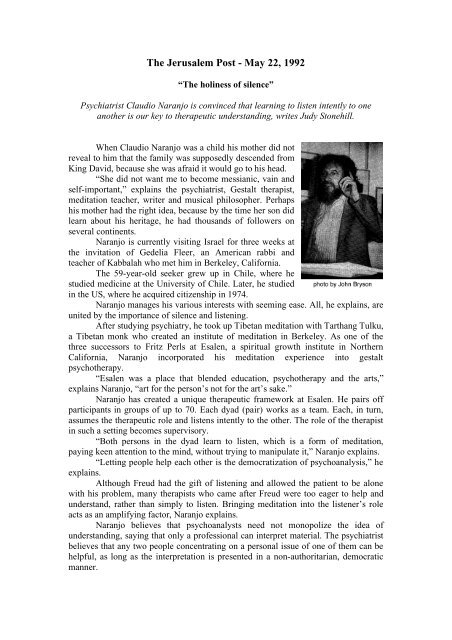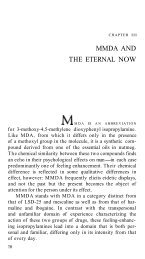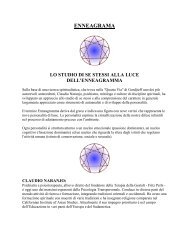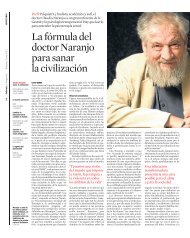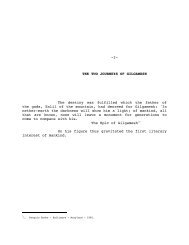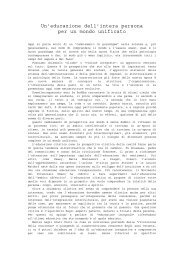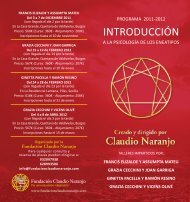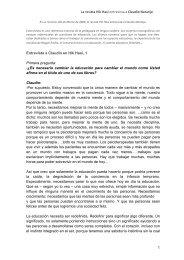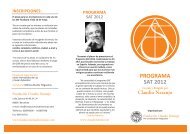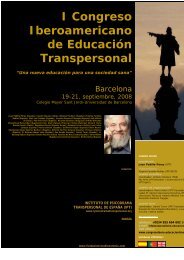The Holiness of Silence - Claudio Naranjo
The Holiness of Silence - Claudio Naranjo
The Holiness of Silence - Claudio Naranjo
Create successful ePaper yourself
Turn your PDF publications into a flip-book with our unique Google optimized e-Paper software.
<strong>The</strong> Jerusalem Post - May 22, 1992<br />
“<strong>The</strong> holiness <strong>of</strong> silence”<br />
Psychiatrist <strong>Claudio</strong> <strong>Naranjo</strong> is convinced that learning to listen intently to one<br />
another is our key to therapeutic understanding, writes Judy Stonehill.<br />
When <strong>Claudio</strong> <strong>Naranjo</strong> was a child his mother did not<br />
reveal to him that the family was supposedly descended from<br />
King David, because she was afraid it would go to his head.<br />
“She did not want me to become messianic, vain and<br />
self-important,” explains the psychiatrist, Gestalt therapist,<br />
meditation teacher, writer and musical philosopher. Perhaps<br />
his mother had the right idea, because by the time her son did<br />
learn about his heritage, he had thousands <strong>of</strong> followers on<br />
several continents.<br />
<strong>Naranjo</strong> is currently visiting Israel for three weeks at<br />
the invitation <strong>of</strong> Gedelia Fleer, an American rabbi and<br />
teacher <strong>of</strong> Kabbalah who met him in Berkeley, California.<br />
<strong>The</strong> 59-year-old seeker grew up in Chile, where he<br />
studied medicine at the University <strong>of</strong> Chile. Later, he studied<br />
in the US, where he acquired citizenship in 1974.<br />
<strong>Naranjo</strong> manages his various interests with seeming ease. All, he explains, are<br />
united by the importance <strong>of</strong> silence and listening.<br />
After studying psychiatry, he took up Tibetan meditation with Tarthang Tulku,<br />
a Tibetan monk who created an institute <strong>of</strong> meditation in Berkeley. As one <strong>of</strong> the<br />
three successors to Fritz Perls at Esalen, a spiritual growth institute in Northern<br />
California, <strong>Naranjo</strong> incorporated his meditation experience into gestalt<br />
psychotherapy.<br />
“Esalen was a place that blended education, psychotherapy and the arts,”<br />
explains <strong>Naranjo</strong>, “art for the person’s not for the art’s sake.”<br />
<strong>Naranjo</strong> has created a unique therapeutic framework at Esalen. He pairs <strong>of</strong>f<br />
participants in groups <strong>of</strong> up to 70. Each dyad (pair) works as a team. Each, in turn,<br />
assumes the therapeutic role and listens intently to the other. <strong>The</strong> role <strong>of</strong> the therapist<br />
in such a setting becomes supervisory.<br />
“Both persons in the dyad learn to listen, which is a form <strong>of</strong> meditation,<br />
paying keen attention to the mind, without trying to manipulate it,” <strong>Naranjo</strong> explains.<br />
“Letting people help each other is the democratization <strong>of</strong> psychoanalysis,” he<br />
explains.<br />
Although Freud had the gift <strong>of</strong> listening and allowed the patient to be alone<br />
with his problem, many therapists who came after Freud were too eager to help and<br />
understand, rather than simply to listen. Bringing meditation into the listener’s role<br />
acts as an amplifying factor, <strong>Naranjo</strong> explains.<br />
<strong>Naranjo</strong> believes that psychoanalysts need not monopolize the idea <strong>of</strong><br />
understanding, saying that only a pr<strong>of</strong>essional can interpret material. <strong>The</strong> psychiatrist<br />
believes that any two people concentrating on a personal issue <strong>of</strong> one <strong>of</strong> them can be<br />
helpful, as long as the interpretation is presented in a non-authoritarian, democratic<br />
manner.
<strong>Naranjo</strong> was named after <strong>Claudio</strong> Arrau, one <strong>of</strong> the great pianists <strong>of</strong> this century. He<br />
compares his parents’ home in Chile to the Mendelssohn home in Germany <strong>of</strong> the last<br />
century. “It was more <strong>of</strong> a salon. All the world class musicians who came to perform<br />
in Chile came to our home.”<br />
His mother was an amateur pianist and the first woman lawyer in Chile. His<br />
father was treasurer <strong>of</strong> the province.<br />
When <strong>Naranjo</strong> was six, he began studying piano. By 10, he was learning<br />
musical composition. But it was not till many years later that he integrated his<br />
musical background with his spiritual training in meditation.<br />
“<strong>The</strong> most important person in my life was Ichazo, a Bolivian Sufi [Islamic<br />
mysticism] master. Ichazo sent me out into the Chilean desert alone for 40 days, after<br />
the tragic death <strong>of</strong> my 11-year-old son . “If his death was to have any meaning, it<br />
could only be in my own inner rebirth,” <strong>Naranjo</strong> says. “And that is what began in the<br />
desert.”<br />
Later, <strong>Naranjo</strong> was influenced by the Chilean sculptor Tótila Albert, who himself<br />
underwent a spontaneous spiritual transformation after the death <strong>of</strong> his father. At the<br />
end <strong>of</strong> his internal odyssey, which lasted 10 years, Albert claimed to perceive words<br />
written in the music <strong>of</strong> Beethoven.<br />
Says <strong>Naranjo</strong>: “Albert had a keen intuition that Beethoven had undergone a<br />
deep spiritual journey. He explored Beethoven’s music to see if he could reconstitute,<br />
or decode, the musical language. Eventually, Albert heard words in the music –<br />
German words. It was an awesome experience, like meeting a ghost.”<br />
Popular musicology, <strong>Naranjo</strong> explains, contends that music does not say<br />
anything, that it has no meaning beyond its sound, that it is pure art, the abstract<br />
pleasure <strong>of</strong> the ear.”<br />
But “this popular notion goes against the sacred origins <strong>of</strong> music,” he says,<br />
“which were to elevate consciousness.” <strong>Naranjo</strong> believes there is a grammatical<br />
structure in music which can be deciphered. Once deciphered, the listener can<br />
appreciate the spiritual experience <strong>of</strong> the composer.<br />
<strong>Naranjo</strong> has constructed a theory to answer the question: How does music<br />
express experience? He explains the grammar <strong>of</strong> musical language. Each <strong>of</strong> the seven<br />
notes <strong>of</strong> the scale is connected to a quality <strong>of</strong> experience. Each <strong>of</strong> the 12 notes in the<br />
chromatic scale can be connected to the others, forming 11 ascending combinations<br />
and 11 descending ones. <strong>The</strong>se intervals are the letters from which the music is made,<br />
forming words, then sentences.<br />
“Sound is the most direct expression <strong>of</strong> holiness, outside silence,” <strong>Naranjo</strong><br />
explains.<br />
“Sounds says ‘I am.’ It is more powerful than visual symbols or words. Music<br />
is the expression <strong>of</strong> spiritual experience and should be listened to as if someone is<br />
telling you something very wise.”<br />
<strong>Naranjo</strong> defines himself as “a special kind <strong>of</strong> Jew.” Because my grandmother<br />
experienced pogroms in Vilna, she suppressed Jewish consciousness in my mother<br />
and, subsequently, in me.”<br />
But when he was 16 and lying in bed for 40 days suffering from typhoid fever,<br />
<strong>Naranjo</strong> read a book about the Kabbalah. Ever since then, he has had a deep longing<br />
to know more.<br />
This is <strong>Naranjo</strong>’s first visit to Israel, and he is “drawn to coming back,” maybe<br />
even next year, though he can’t explain why.<br />
<strong>Naranjo</strong>’s books include Techniques <strong>of</strong> Gestalt <strong>The</strong>rapy, <strong>The</strong> Healing Journey,<br />
Ennea-Type Structures, <strong>The</strong> One Quest and <strong>The</strong> Psychology <strong>of</strong> Meditation (co-
written with Dr. Robert Ornstein). He is currently writing an autobiography entitled<br />
Up and Down the Holy Mountain.<br />
<strong>Naranjo</strong> will deliver a lecture in English on “Music and Meaning” at 8:30<br />
Sunday, May 24, at the Zionist Confederation House, Emile Botta St. (behind the<br />
King David Hotel).<br />
During his stay in Israel, he has also been conducting “Interpersonal<br />
Extensions <strong>of</strong> Meditation” workshops.


